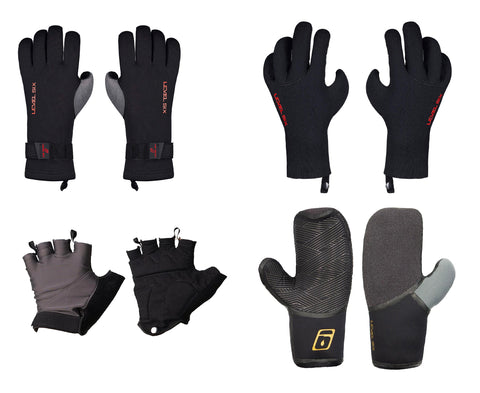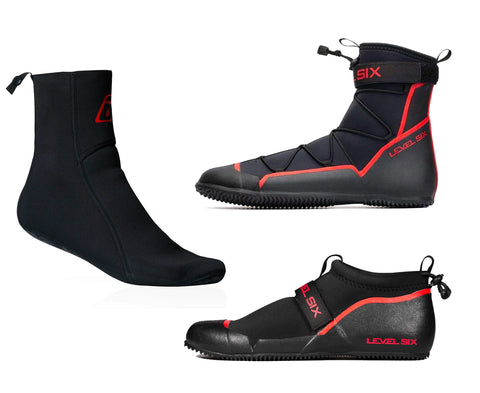
How Neoprene Keeps You Safe: The Benefits of Wearing Neoprene While Paddling
Neoprene is a synthetic rubber material that has been around since the 1930s. It is highly versatile and can be used in a variety of applications, from protective clothing to orthopedic braces. It has many desirable properties, including being lightweight, waterproof, resistant to abrasion, chemicals, and extreme temperatures, and it even offers flame retardancy and insulation.
For paddlers, neoprene is an essential material. It keeps you comfortable, durable, and warm even when the water is cold. It’s also flexible and stretchy, allowing for a full range of movement, and it helps protect you from scrapes or sharp objects.
When to Wear a Wetsuit vs a Dry Suit
A good rule of thumb is to dress for the water, not the air. Neoprene wetsuits are best when water temperatures drop below 16°C (60°F) and can keep you safe well into spring and fall. They work well until about 10°C (50°F). Below that threshold, or if you’re paddling in winter conditions, a full dry suit is the safer choice. Dry suits keep you completely dry and allow you to layer insulating clothing underneath, making them the go-to for sub-10°C water or late fall through early spring paddling.
How Does a Neoprene Wetsuit Work?
Wetsuits are designed to trap a thin layer of water between the suit and the skin. Your body then warms that water, creating insulation against the cold. Neoprene adds buoyancy and flexibility, while different thicknesses offer varying degrees of warmth.

The material of the wetsuit also helps to keep the heat in and the cold out. Neoprene wetsuits are a popular choice as they are lightweight and flexible while also providing excellent insulation. The thickness of the wetsuit can also play a role in its effectiveness at keeping the wearer warm, with thicker suits providing more insulation.
The most common neoprene products are wetsuits, gloves and booties.
OVAP’s Recommended Gear
Here at OVAP, we are huge fans of the Canadian brand Level Six. We’ve carried their gear for years, wear it ourselves, and stand by it because it’s tried, trusted, and sustainable. Level Six is Canadian-owned and has taken major steps toward eco-friendliness by eliminating PFAS “forever chemicals” and using 100% recycled nylon in their clothing.
Wetsuits
Our go-to neoprene option is the Level Six Farmer Jane & John Wetsuits. Built with 3 mm Thermo-Stretch neoprene and a full front zipper, these wetsuits are a durable layering base for paddlers. Think of them as your foundation—you can pair them with fleece or tops like the Jericho or Sobrio Long Sleeve for cooler days.
Splash Tops
For wind and spray protection, add a splash top. Our favourites are the Ellesmere and Torngat Splash Tops. They’re lightweight, breathable, and waterproof, giving you that extra shield on gusty or rainy days.
Plus, they feature an adjustable neoprene waistband and a double cuff wrist system to ensure a snug fit that keeps water out while allowing for easy movement. They have a little neoprene in them, so they're allowed on the blog :P
 Dry Suits
Dry Suits
Dry suits are essential once temperatures drop below 10°C or when paddling in icy waters. While we don’t stock them on our shelves, we can special-order Level Six dry suits for you, and they arrive in 1-2 business days. These suits are made with tough, waterproof-breathable nylon and are designed for the coldest conditions.
*We do not carry any of the Level Six dry suits at our store, but if you would like one, please give us a shout and we can special order one in for you! It will be at our store in 1-2 business days.
 Neoprene Gloves
Neoprene Gloves
Cold hands can end a paddle early. We carry Level Six Proton Gloves and Cascade Gloves—both designed for warmth, dexterity, and grip.
Neoprene Booties and Socks
Keep your feet warm and protected with:
-
Level Six River Boot 2.0: Redesigned with a vulcanized rubber sole and 3 mm neoprene for comfort and grip.
-
Level Six Photon Socks: Lightweight neoprene socks with traction soles, perfect inside shoes or sandals.
Pros and Cons of Wetsuits
Pros:
-
Lightweight and flexible for comfort
-
Excellent insulation in cool water
-
Extra buoyancy and abrasion resistance
-
UV and mildew resistant
Cons:
-
Not fully dry like a dry suit
-
Less effective below 10°C water
-
Requires proper care to avoid cracking
-
Not breathable in hot climates
When to Wear Neoprene
The ideal temperature at which you should break out your neoprene clothing varies on the individual, as well as the articles of clothing. Generally speaking, wetsuits should be worn when the water temperature is below 16°C (60°F) which means you can easily extend your paddling season into the spring or fall! You can also opt for sleeveless neoprene if the air is warmer but the water temperature is cool. On warmer days, you may still want to throw on your neoprene gloves or booties to keep your hands and feet dry. Did you know that water can pull heat out of your body 25-30x faster than air can? This is why hypothermia is so much more common if you are submerged in water.
Neoprene Thickness Guide
-
0.5–1.5 mm: Summer layering pieces (tops, shorts, leggings)
-
2–3 mm: Spring and fall paddling
-
3+ mm or dry suit layering: Cold water or winter paddling
What Else Should I Wear?
Neoprene makes a fantastic base layer, but you will need to wear more clothing over top, especially in cold weather conditions. Neoprene provides great insulation and flexibility for your water adventures. However, depending on the temperature, time of year, and your specific activity, you will probably want to want to layer up. Consider adding a cozy fleece sweater to keep your upper body warm, and pair it with a splash jacket. Opt for windbreaker pants to shield yourself from chilly winds. Dry-fit shirts and pants are also great choices, offering moisture-wicking properties to keep you comfortable during your aquatic endeavours. Remember that the key is to strike a balance between staying warm and maintaining ease of movement, so choose clothing that suits both your needs and the conditions you'll be facing.
Neoprene for Fishing
When embarking on a kayak, canoe, or SUP fishing expedition in cooler temperatures, wearing neoprene clothing can be a game-changer for your safety and comfort. It can get chilly when sitting for an extended period of time waiting for that first bite. Neoprene provides excellent insulation and acts as a heat shield while you patiently wait. This is particularly beneficial when you're out on the water for extended periods. For optimum protection, consider wearing a neoprene wetsuit, gloves, and booties. The material is flexible, allowing for a wide range of motion which is essential when casting a line. Investing in good quality neoprene clothing can elevate your fishing experience by keeping you warm, giving you greater freedom of movement, and offering an added layer of buoyancy and safety.

How Thick Should My Neoprene Be?
The thickness of your neoprene clothing depends on the water temperature and personal preference. Generally speaking, for paddling in the spring or fall, a 2-3mm wetsuit should be sufficient. If you are thinking of paddling on a cooler day in the summer, a 0.5mm - 1.5 top, shorts, or Ieggings is also a great option. It’s important to consider the air temperature and other environmental factors when choosing the appropriate thickness of your wetsuit.

How to Care for Your Neoprene
To care for your wetsuit, gloves and booties properly, you should rinse them in cold water after each use to remove any dirt, sand, or other debris. After rinsing, hang your wetsuit in a dry, well-ventilated area to air dry. Though hand washing is best, it is possible to wash your neoprene in a washing machine on a gentle cycle. Be sure to use a neoprene-specific cleaning solution such as Revivex Wetsuit & Drysuit Shampoo Cleaner. For a comprehensive guide on cleaning your neoprene, check out this great guide by Gearaid.
What About Dry Suits?
If you are interested in a Level Six Dry Suit, we can special order one of these bad boys for you. These suits are constructed using the toughest waterproof-breathable nylon; keeping you warm and dry in sub-zero temperatures. From hitting your SUP on a winter day, to whitewater canoeing and kayaking, the dry suits will keep you cozy and comfy on the chilliest of days.
In Conclusion
Neoprene is best worn when paddling in cooler temperatures, such as in the spring or fall. If you are an avid paddler who wants to participate in your favourite water sport during the off-season, then neoprene products might be for you! Or, if you are looking for an outfit that will keep you safe from knicks and cuts as well as protect you from the harsh rays of the sun, you may also want to consider a wetsuit. All in all, we definitely recommend wearing protective neoprene gear when embarking on any sort of paddling adventure in water temperatures 16°C or cooler.
What to wear in the summertime? During warmer months, you can opt for lighter-weight, less insulated alternatives such as rash guards or board shorts.
Always remember to stay safe on the water at any time of the year, but take extra precaution when the temperatures are lower. Happy paddling!







